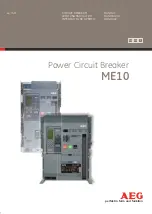
Fuse Carriage
3. Remove the safety barriers of the fuse carriage to allow
access to the main power fuses. Disconnect the two small
(No.
14
AWG) wires from the top terminals of the power
fuses. Connect the two small wires of each phase
together. Keep them insulated from the top of the fuse.
Remove the trigger fuse cover and remove the trigger
fuses.
4.
Close the circuit breaker. Apply voltage to the terminals in
the trigger fuse block, preferably from a variable trans
former with a voltmeter, although
120
VAC can be used.
The voltage is applied between the terminals where the
trigger fuses were mounted, one phase at a time. The
circuit breaker must trip at
120
VAC or less. Remove the
voltage, reset the open fuse trip device on the circuit
breaker and reclose the circuit breaker for the next test.
Repeat the test for each of the three phases.
22
5.Replace the trigger fuses. Reconnect the two wires to the
top of each fuse terminal, and replace the safety barriers
and covers, before racking the units back to the con
nected position.
Maintenance
Occasional checking and cleaning of the circuit breaker and
fuse carriage will promote long and trouble-free service. A
periodic inspection and servicing should be included in the
maintenance routine.
Refer to the Maintenance Section,
Page
10,
for recom
mended inspection and maintenance procedures applicable
to RLF fused circuit breakers and to RFC fuse carriages.
www
. ElectricalPartManuals
. com































